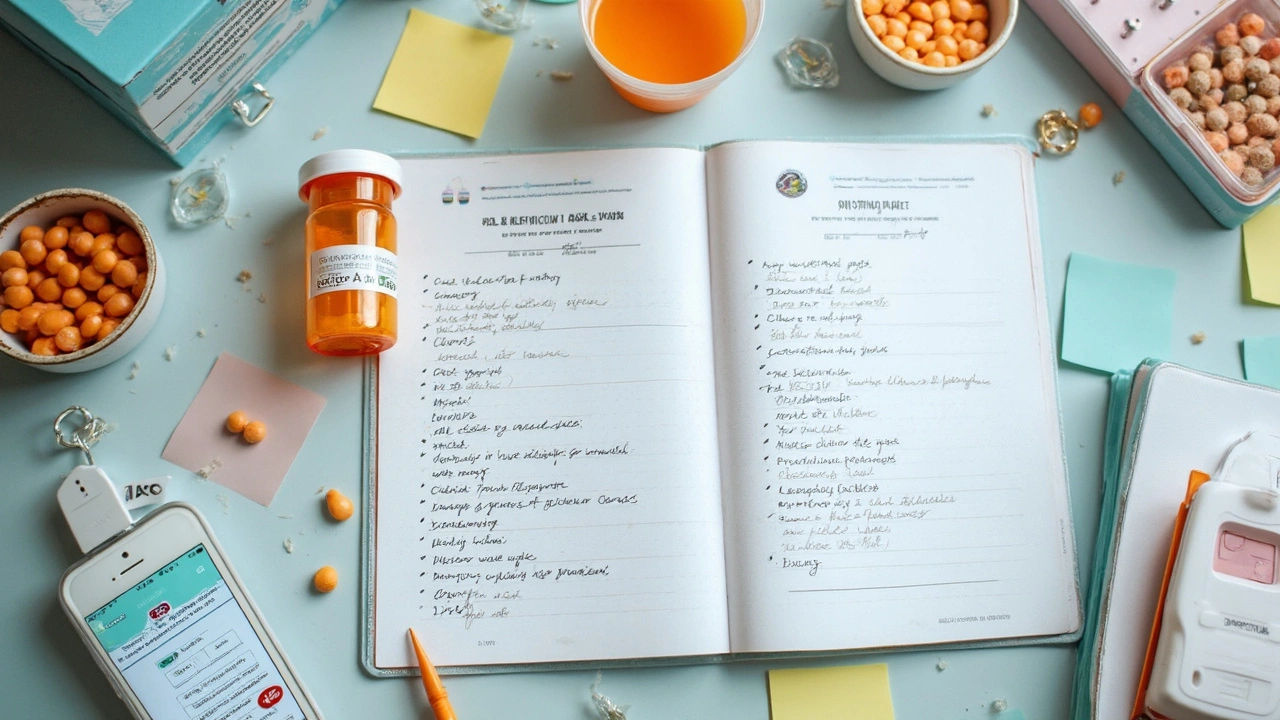Clarithromycin and Celiac Disease: What You Need to Know for Safe Use
 May, 29 2025
May, 29 2025
Picture this: you’re feeling lousy, your doctor hands over a prescription for clarithromycin, and the pharmacist says everything checks out. Simple, right? But if you’ve got celiac disease, your brain just hit pause. That underlying worry—could this antibiotic trigger a gluten reaction? It’s a thought that sticks with anyone who’s ever read a medication label and seen a mystery ingredient or vague pharmaceutical jargon. The truth is, with celiac disease, you never want to guess when it comes to what goes in your body—especially with meds.
Clarithromycin in the World of Gluten-Free Medications
Let’s talk about clarithromycin. This antibiotic is commonly used to treat chest infections, sinusitis, strep throat, and even some stomach ulcers. Sounds harmless enough, but what goes into every pill, powder, or liquid version isn’t always as clear. For people with celiac disease, medication isn’t just about the active ingredient, but every filler, binder, and hidden additive stashed in the bottle. Gluten can pop up where you’d least expect it: maltodextrin (if sourced from wheat), pregelatinized starch, or mysterious excipients.
So, what’s the actual risk when your doctor prescribes clarithromycin? Here’s the good news: the active ingredient—clarithromycin itself—is gluten free. But things get murkier when you start digging into the so-called "inactive“ ingredients. Drug manufacturers sometimes use wheat-derived fillers, especially in cheaper generics or certain regions. Think it’s some allergy panic? Nope—pharmaceutical gluten exposure has caused real gut flare-ups in people with celiac. There’s even a term for it: non-dietary gluten exposure.
Let’s hit pause and talk numbers. According to 2024 data from the National Foundation for Celiac Awareness, just under 4% of generic medications tested in the U.S. contained gluten traces, usually from starch additives. While that sounds small, the immune system of someone with celiac disease doesn’t need a lot to start raising havoc. A sliver of gluten (as little as 10 mg per day) can damage the gut lining. For reference, a single crumb of bread is about 5,000 mg of gluten. But meds—unlike food—are hard to double check for gluten before swallowing.
Here’s a little tip: always check the drug insert for terms like "starch," "pregelatinized starch," or ambiguous "modified food starch." If it doesn’t say the source (corn, potato, rice), ask the pharmacist or call the drug maker’s customer line. A lot of brands list a direct number inside the box for questions just like this. The FDA passed guidance in 2020 encouraging drugmakers to disclose major allergens, but gluten is awkwardly left out, so don’t rely on packaging alone.
People with celiac disease who take regular medication—whether for infections, heartburn, or anxiety—tend to be more sensitive to trace gluten amounts than most. That’s why double and triple checking matters. Many U.S. pharmacists are now trained to flag medications that might contain gluten. If your pharmacy isn’t sure, there are databases like GlutenFreeDrugs.com run by Dr. Steve Plogsted, which list gluten-free versions of common drugs (including clarithromycin). The key? Don’t be shy about asking every time.
Some hospital systems in Europe have started to label prescription labels with a green sticker for gluten free and a red sticker for "check with doctor/pharmacist." Wish that existed everywhere, right? Until then, it’s best to keep a small paper list of your safe meds and update it whenever your prescription changes. Going digital? There are even smartphone apps now that scan drug barcodes and check gluten status instantly. It’s not perfect, but it beats guessing.
Just to throw in an example: Amoxicillin, another antibiotic, is almost always gluten-free from all major suppliers, but clarithromycin liquid forms sometimes list starches without stating the source. If you’re prescribed a liquid (used for kids or older adults with trouble swallowing pills), double-check the ingredient list each time you refill.
When in doubt, bring the box or syrup bottle with you to your next doctor’s appointment. Point to the weird ingredient, and have them call the manufacturer with you present. Don’t put up with “It’s probably fine”—your gut deserves more certainty. Small steps like these can save you from weeks of stomach trouble or an accidental celiac flare-up.

The Science: How Clarithromycin Affects Celiac Patients
You might be wondering, does clarithromycin directly mess with celiac disease, or is it all about the additives? Let’s clear that up. The mechanism of clarithromycin has nothing to do with gluten—this drug works by interfering with protein creation in bacteria, not humans. It doesn’t trigger the autoimmune reaction that’s the trademark of celiac disease unless gluten sneaks in alongside it. But funny enough, antibiotics themselves can have some side effects that feel suspiciously like gluten contamination.
Take this: many people on antibiotics get gut symptoms—diarrhea, cramping, and nausea—that can mimic a gluten reaction. The reason? Clarithromycin, like most antibiotics, wipes out some good gut bacteria while fighting infections. This microbiome dip can leave people with celiac feeling wiped out, especially since their digestive systems start a step behind. A study published in the Journal of Clinical Gastroenterology in 2022 found that celiac patients taking antibiotics reported a 30% greater incidence of temporary stomach upset compared to non-celiac controls. The culprit wasn’t the gluten—it was the natural bacterial shake-up in the gut.
So, is it dangerous? Not usually, but it does mean you have to be more careful about side effects. On top of the usual worries about gluten exposure, celiac patients are at higher risk for things like yeast infections (because antibiotics drop good bacteria) and Vitamin K or D malabsorption if the gut is inflamed. That’s why it’s a solid idea to keep an eye out for new symptoms while on any antibiotic, not just clarithromycin.
Another twist is that people with long-undiagnosed celiac disease sometimes have weaker immune defenses. That means bacterial infections tend to linger or get more severe. Clarithromycin can be a lifesaver when a nasty bug hits, but don’t be surprised if your body needs a bit more TLC while taking it. Hydrate, rest up, and consider adding a good probiotic (just make sure it’s truly gluten-free! Some are not).
For the especially careful: ask your doctor to check your vitamin and mineral levels if you’re on antibiotics more than a week or so. Gut healing can lag behind, and a few extra weeks of B12 or D3 supplementation can be the difference between bouncing back and feeling wiped out for months. If your medication leaves you feeling off, check with the doctor. Don’t just accept it as normal. You’re the expert on your own body.
It’s worth noting that the number of celiac adults newly diagnosed in the last five years has shot up by about 16% in North America, according to a 2023 Mayo Clinic report. That means more people than ever are navigating these medication landmines for the first time. If you’re one of them, trust your gut (pun intended) and advocate for clarity at the pharmacy every time.
Your doctor is your teammate. If clarithromycin doesn’t feel right or a suspicious batch sends your gut instincts into overdrive, don’t be quiet about it. There’s almost always an alternative antibiotic, so don’t settle for stomach misery. Keep those communication lines open, and plan ahead for every prescription run.

Tips for Staying Safe: Practical Steps for Celiac Patients on Antibiotics
Navigating antibiotics with celiac disease might feel like a recipe for never-ending stress, but a few tried-and-true hacks can make life a lot smoother. Here’s what helps most:
- Start by asking your doctor or pharmacist before you fill a prescription: "Is this definitely gluten free?" If they’re unsure, ask for the manufacturer’s number or the official drug listing. Keep the label handy for every new brand, even with the same prescription.
- Keep a small notebook or phone list of gluten-safe versions of your go-to meds, especially antibiotics, antihistamines, and painkillers. Update it if anything changes or if a new generic gets dispensed.
- Download a trustworthy drug database app. Many are updated monthly and can cross-check ingredients by brand and region (handy if you ever travel overseas).
- Double check liquids and chewables—these often have added flavors or sweeteners that can hide wheat starch or maltodextrin. Tablets are less risky but not always 100% safe.
- Get in the habit of spotting vague terms: “starch” by itself can spell trouble. When in doubt, corn starch is safe, but wheat-based starch isn’t. Don’t settle for “probably gluten free”—unless the source is clear, press for an answer.
- If you experience symptoms like gut pain, bloating, or new fatigue on a med, write it down and call the doctor. You could be reacting to a filler, not the medicine itself.
- Remember, gluten is not considered a major pharmaceutical allergen by many drug makers. Your vigilance is often your best guardrail.
- Consider probiotics to help rebalance gut flora after antibiotics. Make sure the one you choose states gluten-free status on the packaging (most leading U.S. brands do by now).
- If you’re supporting a child or elderly relative with celiac, keep a laminated list of safe meds for caregivers or emergency visits.
- For travel: European meds can have different fillers. Carry a doctor’s note listing "requires gluten-free medication due to celiac disease" in the local language if you’re going abroad.
Take the extra time each time you receive a prescription—what matters most is your gut health. A few awkward phone calls or double-checks are a lot easier than weeks of pain or months of healing after gluten exposure. You’ll get savvier and more confident at spotting the red flags.
Just so you get the lay of the land, here’s a quick table showing basic gluten-risk in common clarithromycin forms in the U.S. as of June 2025:
| Form | Known Gluten Risk | Check Each Brand? |
|---|---|---|
| Clarithromycin tablets (500 mg) | Low | Sometimes, generics may vary |
| Clarithromycin powder for suspension (liquid) | Medium | Always—watch for starches, flavors |
| Clarithromycin extended release | Low | Ask about fillers in generics |
Sticking to your gluten-free diet isn’t about being hypervigilant or fearful—it’s about setting yourself up for better days ahead. Medication surprises are one of the last unturned stones, but by asking the right questions and expecting clear answers, you can rest easier the next time you need an antibiotic. Celiac awareness is finally hitting more doctors’ offices and pharmacies, but until everything’s fully labeled, your quick thinking and curiosity are your best tools. Stay sharp, read every label, and don’t be afraid to make a fuss. Your health’s totally worth it.
Neil Collette
July 18, 2025 AT 16:46Oh, here we go again—another so-called "safe" antibiotic for folks with celiac disease. Look, I get it, clarithromycin is a common go-to, but the idea that it’s completely safe? That’s a stretch. For one, the pharmaceutical supply chain isn't exactly spotless when it comes to gluten contamination, and these things matter.
Also, side effects get played down way too much in these simple articles. If you have a sensitive gut, even minor irritants can spiral into a nightmare. People tend to think "antibiotic" and "no big deal" like this stuff is just candy, but reality check: it’s messing with your microbiome something fierce.
Honestly, anyone with celiac ought to discuss every med with their doc and not just nod along to generic advice. We’re talking about immune system triggers here — a lot’s at stake. So no, clarithromycin isn’t inherently gluten-free just because the label doesn’t scream it out loud. Stay vigilant, folks.
Sonia Michelle
July 18, 2025 AT 18:10I really appreciate this thread because managing celiac disease can be so tricky especially when it comes to medications. The article highlights a crucial point: many antibiotics including clarithromycin themselves don’t contain gluten as an ingredient, but cross-contamination and excipients can be a concern.
It's always smart to check with pharmacists and healthcare providers about sourcing gluten-free medications. I've learned that while being cautious is important, keeping an open and calm dialogue with your doctor is the most effective strategy.
Also, the tips for managing celiac while on antibiotics are practical and empowering. Remember that your health journey is individual, and educating yourself with credible information helps make informed decisions safely.
Kara Guilbert
July 23, 2025 AT 21:46As someone who deals with celiac disease, I cannot stress enough how important it is to not blindly accept any medication without doing your homework first. Gluten sneaking into antibiotics or other drugs is a real problem for many of us.
This article is a good start, but honestly, I've seen so many people suffer because they took meds that weren’t verified gluten-free. I know it’s annoying to have to double-check everything, but it’s a necessary pain for our health.
People with celiac should also advocate for clearer labeling on medications because right now it's a guessing game for most of us.
KIRAN nadarla
July 24, 2025 AT 11:40Grammar aside, the truth here is pretty straightforward, though the dramatics about contamination do get a little played out. Clarithromycin chemically is not gluten-containing; ingredients in the pills are usually safe if sourced responsibly. But yeah, over-cautiousness is understandable — no argument there.
Still, sometimes people panic about 'gluten' in medications when it’s negligible or symbolic. If you read the official FDA guidelines, leftover gluten traces below 20 ppm are generally considered safe for celiac patients, so not every pill is a minefield.
My take? Do your research, but don’t overthink to the point of paranoia.
Abhimanyu Singh Rathore
July 26, 2025 AT 05:20Okay, I must jump in to point out some punctuation and syntax errors in the original post and some comments — it’s crucial to communicate health info clearly and correctly to avoid confusion. For instance, clarithromycin’s explanation lacks a comma where it’s needed, and sentence flow can be better structured.
But content-wise, the article’s helpful in emphasizing how celiac patients must approach antibiotics with caution, especially considering gluten contamination risks in inactive ingredients.
Precision in language and medical clarity go hand in hand here!
Kasey Lauren
August 1, 2025 AT 00:13This post is really reassuring! When I was first diagnosed with celiac, I was terrified of taking any medication without knowing for sure whether it was gluten-free or not.
It’s so helpful to have straightforward info on clarithromycin because sometimes doctors and pharmacists don’t seem to understand the necessity of gluten-free meds for us.
Thanks for breaking it down and giving practical tips on how to manage while taking antibiotics. That’s exactly the info I needed!
Badal Patel
August 2, 2025 AT 04:00Actually, I must strongly disagree with the notion that clarithromycin is completely safe without consideration of sourcing and manufacturing. Anyone with basic pharmacology knowledge knows that excipients can vary by manufacturer and region. Not all formulations worldwide maintain gluten-free standards, which is a crucial factor for celiac patients.
I implore the readers to delve into databases or consult specialized pharmacists that track gluten content in medications globally. Safety must never be assumed—it must be verified. Otherwise, one risks avoidable exposures and potentially worsening their condition.
Furthermore, the tone of casual safety reassurance might mislead patients into complacency, and that is unacceptable in matters of chronic illness and immune sensitivity.
Dennis Scholing
August 6, 2025 AT 19:06Greetings to everyone here! Let me take a moment to impart some formal guidance that may be useful to you all. It is imperative when dealing with celiac disease to consult healthcare professionals who are well versed in both gastroenterology and pharmacology before administering any antibiotic, including clarithromycin.
Be mindful that the label alone does not guarantee gluten exclusion, as excipients and manufacturing processes may differ significantly. Hence, seeking out gluten-free certifications or contacting pharmaceutical companies directly is a recommended practice.
Remember, through thoughtful inquiry and partnership with your medical providers, you can effectively manage your health while mitigating any potential risks.
Lynn Kline
August 10, 2025 AT 06:26Wow, this post is super helpful! Thanks! I’ve struggled with celiac and antibiotics before and it’s so scary not knowing if your meds are messing up your gut more.
One thing I try to remember is to always keep open communication with your pharmacist because they can sometimes find gluten-free alternatives or even compounding options.
Also, staying positive and proactive is key—don’t let anxiety take over when managing stuff like this. Knowledge really is power!
Stephen Lewis
August 14, 2025 AT 21:33In respect to the ongoing discussion, I would like to add that it is of utmost importance to approach this matter with a methodical and evidence-based mindset. Clinical studies assessing the safety of clarithromycin in celiac patients are limited, but available data suggests the active ingredient does not inherently contain gluten.
Nonetheless, as many have rightly pointed out, the variability among manufacturers concerning gluten in excipients must not be ignored. Consulting official databases and corroborating information with certified specialists is a prudent pathway.
It is advisable to document any adverse symptoms following drug administration and report these to your healthcare provider immediately to ensure optimal management.
James Lee
August 17, 2025 AT 05:06Ugh, the whole gluten in meds conversation again. Look, I get the concern, but really, let’s not pretend like this is some epic threat lurking under every pill. Clarithromycin’s chemical composition doesn’t include gluten, and the chances of contamination are pretty slim if you’re careful about where you get your meds.
Honestly, too much fuss about gluten in medications sometimes turns celiac from a serious autoimmune issue into just another internet panic fest. Moderation in worry is wise.
Still, it’s smart to ask questions but don’t get caught in a cycle of unnecessary dread.